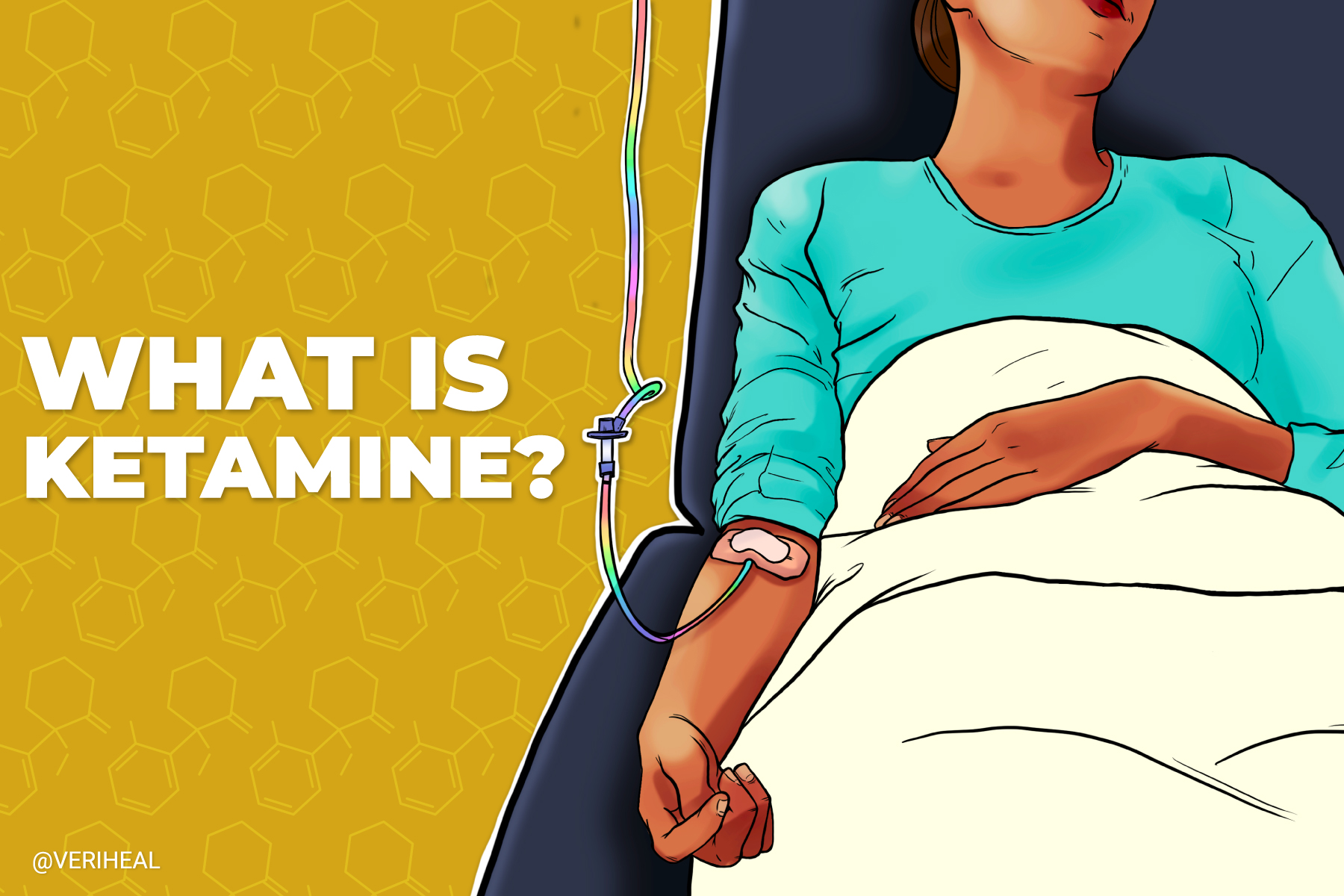Ketamine, with its “triple-threat of sedative, stimulating, and psychedelic effects,” according to The Cut, has a wild and elusive history. First approved by the U.S. Food and Drug Administration (FDA) in 1970 as a wartime anesthetic, ketamine turned into a popular party drug feared by parents everywhere before eventually being considered as a treatment for depression in the 2000s.
The Cut’s account of a ketamine experience, titled “Leave Your Body at the Door,” explains that the substance “numbs your body and makes you feel apart from your environment,” and “that doesn’t begin to capture the weirdness of what it feels like to get high on K [ketamine].” While the drug has become commonly associated with its unique dissociative effects, it turns out to be abundant with quick-acting therapeutic properties too.
What Is Ketamine?
Ketamine is categorized as a dissociative anesthetic that sends users into the “K-Hole,” or “the full dissociative experience that ravages your speech capabilities and motor functions (8).” The ketamine high reportedly feels like “walking from your kitchen to your living room, and from your living room to your kitchen, and it’s uphill both ways, but you’ve never had so much fun walking up a hill.”
Under the Controlled Substance Act (CSA), ketamine is listed as a Schedule III drug, meaning the U.S. government considers it to have medical use and “a moderate to low potential for physical and psychological dependence.” It’s approved for use in hospitals and veterinarian clinics but remains illegal for other uses (2). Recreational (illegal) ketamine is commonly referred to as K, Special K, Kit Kat, Super K, super acid, and more.
Dissociative anesthetics belong to a class of psychedelic drugs that distort perception, including sensory perception. Medical News Today explains that other drugs belonging to this categorization include phencyclidine (PCP), dextromethorphan (DXM), and nitrous oxide (laughing gas) (1). Ketamine is a noncompetitive N-methyl-D-aspartate (NMDA) receptor antagonist, which is why it is useful as anesthesia.
Ketamine is thought to work like a flash mob, temporarily taking over a certain chemical receptor, which can be a good thing when taken under medical supervision (6). So, what does that look like? Let’s find out.
Ketamine’s Medical Uses
Ketamine is mostly used in veterinary medicine but can be used on humans as well to induce and maintain general anesthesia before, during, and after surgery. According to Medical News Today, the substance is considered to be a safe anesthetic when taken as prescribed by a doctor (1). In fact, it’s a suitable option for less wealthy countries and disaster zones due to the fact that it doesn’t require an electricity supply, oxygen, or highly trained staff.
Why You Should Get Your Medical Marijuana Card
Veriheal has satisfied millions of patients nationwide by giving them access to these benefits
- Larger purchase limits
- Peace of mind
- Enhanced legal protection
- Access to higher potency strains
- Save up to 25% on cannabis purchases
- Skip the line at the dispensary
In human medicine, ketamine is utilized as an anesthetic in procedures such as cardiac catheterization, skin grafts, orthopedic procedures, diagnostic procedures on the eye, ears, nose, and throat, and minor surgical interventions such as dental extractions. It can also alleviate pain in small doses and has been used to control seizures, but this is only considered after five or six other treatment options have proven ineffective.
Additionally, ketamine has been proven through studies to reduce symptoms associated with PTSD and depression. One 2019 study published in the Indian Journal of Psychiatry found significant improvement in participants with severe depression after using ketamine for just two weeks and was sustained for a month (7). A randomized, double-blind, crossover trial conducted from 2009 to 2012 discovered ketamine’s ability to significantly and rapidly reduce PTSD symptoms more effectively than midazolam, a medical anxiolytic and sedative.
How Is Ketamine Consumed?
Illegal ketamine comes in the form of a white crystalline powder, which can then be made into tablets, pills, or even dissolved into a liquid form. When used as a medical anesthetic, the substance is typically injected into a muscle, snorted nasally, or given through an intravenous (IV) line. When using ketamine as a treatment for depression and other psychiatric conditions, health professionals often opt for intranasal esketamine (a selected ketamine enantiomer) or ketamine infusion therapy, which takes a couple of different forms. Only intranasal esketamine (Spravato, S-ketamine) is FDA-approved for refractory depression while other forms like IV are not (3).
According to Pacific Psych Centers, ketamine infusion therapy is used to treat depression symptoms in patients who don’t respond to traditional drugs like selective serotonin reuptake inhibitors (SSRIs) and is believed to repair damage to the brain done by long-term stress. While IV ketamine is considered “off-label” when used as a treatment for depression because it is not approved by the FDA for psychiatric purposes as esketamine is, patients and researchers anecdotally report it to be relatively safe and effective for mental health treatment (5).
Ketamine infusion therapy is either administered directly into the bloodstream through an IV or as a nasal spray known as esketamine (Spravato). At Pacific Psych Centers, patients “typically receive a series of six infusions over two to three weeks” before later returning for one infusion every two to six weeks (5). While eksetamine is FDA-approved, it is said to be less researched for treating depression and is in need of more research to prove its effectiveness and efficacy.
Risks of Using Ketamine
Ketamine is a drug that should be administered by a professional in a medical setting to unlock its true benefits safely. Otherwise, the potential adverse effects of ketamine include (1):
- Risk of respiratory depression
- Drowsiness and sedation
- Slow, fast, or abnormal heartbeat
- Blood pressure fluctuations and instability
- Risk of dependence
- Changes in perceptions of color or sound
- Hallucinations, confusion, and delirium
- Dissociation from body or identity
- Agitation, anxiety, or panic
- Difficulty thinking or learning
- Nausea or vomiting
- Dilated pupils and changes in eyesight
- Inability to control eye movements
- Involuntary muscle movements and muscle stiffness
- Slurred speech
- Numbness
- Amnesia
- Liver injury
- Emergence reactions
- Behavioral changes
- Increased pressure in the eyes and brain
Please remember to consult a medical professional (preferably your own physician) if you wish to implement ketamine into your treatment plan. While we now know more about ketamine than ever before, professionals are still actively conducting research to understand this diverse substance’s comprehensive benefits and risks.
Note: Veriheal does not support illegally consuming alternative therapeutic substances but acknowledges that it transpires because of the current illicit status, which we strive to change by advocating for research, legal access, and responsible consumption. Always consult a physician before attempting ketamine therapy.
1. Davis, K. (2021, December 12). Ketamine: What is it, uses, treatments, effects, and more effects. Medical News Today. Retrieved December 31, 2021, from https://www.medicalnewstoday.com/articles/302663
2. Drug scheduling. DEA. (n.d.). Retrieved December 31, 2021, from https://www.dea.gov/drug-information/drug-scheduling
3. Emamzadeh, A. (2021, January 18). IV ketamine for treatment-resistant depression. Psychology Today. Retrieved December 31, 2021, from https://www.psychologytoday.com/us/blog/finding-new-home/202101/iv-ketamine-treatment-resistant-depression
4. Feder, A., Parides, M. K., Murrough, J. W., Perez, A. M., Morgan, J. E., Saxena, S., Kirkwood, K., aan het Rot, M., Lapidus, K. A., Wan, L.-B., Iosifescu, D., & Charney, D. S. (2014). Efficacy of intravenous ketamine for treatment of chronic posttraumatic stress disorder. JAMA Psychiatry, 71(6), 681. https://pubmed.ncbi.nlm.nih.gov/24740528/
5. Hollingsworth, D. J. (2021, July 20). What is IV ketamine infusion therapy? Pacific Psych Centers. Retrieved December 31, 2021, from https://pacificpsychcenters.com/general-mental-health/what-is-iv-ketamine-infusion-therapy/
6. Longdom. (n.d.). Ketamine Impact Factor. Anesthesia & Clinical Research. Retrieved December 31, 2021, from https://www.longdom.org/peer-reviewed-journals/ketamine-impact-factor-6556.html
7. Mandal, S., Sinha, V. K., & Goyal, N. (2019). Efficacy of ketamine therapy in the treatment of depression. Indian Journal of Psychiatry, 61(5), 480–485. https://www.ncbi.nlm.nih.gov/pmc/articles/PMC6767816/
8. Silman, A. (2019, November 21). A party drug for the end of the world. The Cut. Retrieved December 31, 2021, from https://www.thecut.com/2019/11/ketamine-disassociation-generation.html
9. A brief history of ketamine: Delray center for healing. A Brief History of Ketamine Comments. (2020, July 23). Retrieved January 5, 2022, from https://www.delraycenter.com/a-brief-history-of-ketamine/
Author, Share & Comments
















